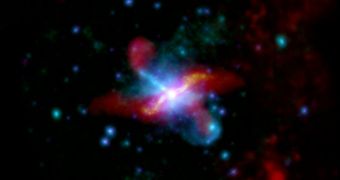Using data from two separate space observatories, a group of astronomers was recently able to confirm that the enormous galaxy Centaurus A is in fact made up of two older galaxies, which collided a long time ago.
In the new investigation, scientists looked at the central regions of Centaurus A in both the infrared and X-ray portions of the electromagnetic spectrum. This enabled them to get a clear view of what is currently going on at the core of the giant structure.
Infrared observations were conducted using the Herschel Space Observatory, a mission conducted by the European Space Agency (ESA) with contributions from NASA. The ESA XMM-Newton telescope was used to survey the target galaxy in X-ray wavelengths.
Centaurus A is relatively close by in astronomical terms, just some 12 million light-years away. Its core shines extremely bright in radio wavelengths, and astronomers believe that a supermassive black hole is responsible for these emissions.
The galaxy has a very complex inner structure, researchers figured out in past investigations. However, observing it in visible light only hinted at the wealth of details available. Since the galactic core is surrounded by gas and dust, optical wavelengths could not penetrate to its central regions.
Thanks to the incredible capabilities of the two ESA observatories, astronomers could look deep within the galaxy, and finally make out its innermost structure. The flattened inner disk of a spiral galaxy was one of the most prominent features the astronomers saw right away.
According to scientists, this formation is a trace of a previous collision between Centaurus A and another elliptical galaxy. The merger must have occurred hundreds of millions to billions of years ago.
“This unique collaboration, along with observations from the ground in visible light, has given us a new perspective on the drama in objects like Centaurus A, with a black hole, star birth and the clashing of two distinct galaxies all rolled into one,” Jet Propulsion Laboratory experts say in a statement.
“The Herschel data also uncover evidence for intense star birth toward the center of the galaxy, along with two jets emanating from the galaxy's core – one of them 15,000 light-years long. Newly discovered clouds co-aligned with the jets can also be seen in Herschel's view,” the team says.
The JPL team coordinate the American part of the Herschel mission. The Lab is managed by the California Institute of Technology, which also manages the NASA Herschel Science Center.

 14 DAY TRIAL //
14 DAY TRIAL //